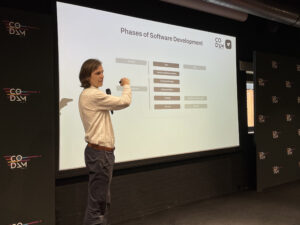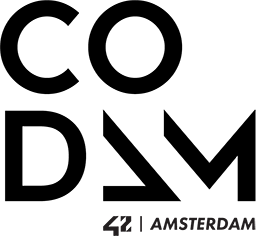23 Jun From idea to product: what makes software engineers great and efficient
In a recent masterclass at Codam, Willem Pino from Rootline delivered an insightful session that went beyond the typical technical tutorial. Titled “From Idea to Product: How Teams Build Software,” Willem’s presentation tackled something crucial that many coding novices overlook—the essential non-technical skills that separate effective software engineers from those who simply know how to code.

Beyond the Code: What Really Makes You Effective
Willem’s central message was clear: becoming a truly effective coder isn’t just about mastering programming languages or frameworks. It’s about understanding the entire ecosystem around software development. While Codam students excel at solving complex coding challenges, the real world presents a different set of problems that require a broader perspective.
“This session is not about technical skills but all the stuff around it,” Willem emphasized, and explained the processes, methodologies, and thinking patterns that define successful software teams.
The Six Phases That Define Every Project
Willem broke down software development into six phases, creating a roadmap that serves both as a project framework and a career development guide:
Ideation marks the beginning, where problems are identified and solutions conceptualized. Functional requirements follow, translating ideas into specific features and capabilities. Technical design involves architecting the solution before any code is written—a step that some eager developers skip but shouldn’t. Implementation is where the actual coding happens, followed by testing to ensure everything works as intended, and finally going live with the finished product.
This framework offers more than just project structure—it provides a career roadmap. As Willem explained, junior developers typically start in the implementation and testing phases, gradually expanding their responsibilities to include technical design, deployment and eventually ideation as they grow into senior roles.
This session is not about technical skills but all the stuff around it.
Real-World Reality Check: How Professional Development Differs
One of the most valuable aspects of Willem’s presentation was his comparison between Codam projects and professional software development. Take Transcendence, the final Codam project in the Common Core curriculum, as an example. Students receive a broad stroke of how it should function with the technical requirements, but they’re missing the technical design phase—and that’s intentional and part of the learning process.
In professional settings, the landscape looks different. You’re working with existing codebases rather than starting from scratch. Users are real people with real feedback, not theoretical personas. Time is spent on operations and maintenance, not just building new features. Technology choices might be constrained by company standards or legacy systems.
Most importantly, you need to think about the overall picture first. Willem warned that jumping straight into implementation without proper technical design leads to unexpected roadblocks that force you to start over—an expensive mistake in professional environments.
Risk Management: The Developer’s Secret Weapon
Willem introduced a novel perspective on software development for many Codam students: viewing it through the lens of risk management. Every project faces two primary risks—something doesn’t work as expected, or you can’t deliver on time. Understanding these risks transforms how you approach development.
The key to mitigation? Short feedback loops. This simple concept underlies every successful software methodology and explains why certain practices have become industry standards.
Waterfall vs. Agile
When Willem addressed project management approaches, he cut through common misconceptions about agile development. “Agile is not sprint/scrum,” he clarified. “It is a way to implement agile.” The distinction matters because agile represents a philosophy of flexibility and responsiveness, while specific frameworks like Scrum are just tools to achieve that philosophy.
His practical advice for Codam students was particularly valuable: work on your Transcendence project using agile principles. This experience allows you to honestly claim agile experience in job interviews—a skill highly valued by employers.
Why Projects Fail and How to Prevent It
Willem’s analysis of project failures resonated with anyone who has experienced the frustration of missed deadlines and scope creep. The culprits are familiar: unexpected complexities that nobody anticipated, impossible deadlines set during the aspirational ideation phase, team dependencies that create bottlenecks, changing requirements, and the dreaded “merge hell” where individually working code fails when combined.
But for every problem, Willem offered solutions. Clear technical designs reduce surprises. Breaking work into small units maintains flexibility. Regular standups maintain momentum. Sprint planning identifies bottlenecks early. Pair programming catches problems before testing. Code reviews smooth the merge process.
The Power of Prototyping and Short Feedback Loops
Willem emphasized the importance of prototyping and wireframing as tools for gathering user feedback early in the process. The goal is simple but powerful: keep feedback loops as short as possible. Every interaction with users, every test, every review is an opportunity to course-correct before problems become expensive to fix.
Tools and Team Alignment
In discussing practical implementation, Willem highlighted how Rootline uses tools like GitLab to maintain agile workflows. Crucially, he emphasized staying close to sales teams to ensure proper project prioritization—in their case, focusing on projects that help close deals. Other companies might use product managers to bridge commercial and technical teams, but the principle remains the same: technical work must align with business objectives.
The Bigger Picture
Willem’s masterclass delivered a crucial message for aspiring software engineers: remember that a project is more than implementation. The most successful developers understand the entire journey from idea to product, master the art of risk mitigation through process, and never lose sight of the business context that drives their technical decisions.
For Codam students preparing to enter the professional world, this masterclass provided invaluable preparation for challenges they won’t encounter in coding exercises but will face every day in their careers.
Discover more masterclasses on our YouTube channel.



